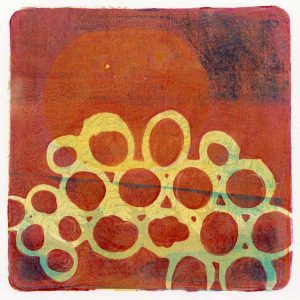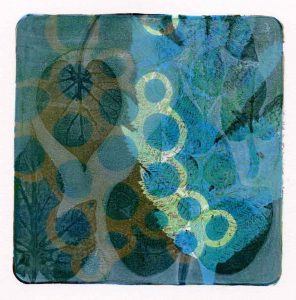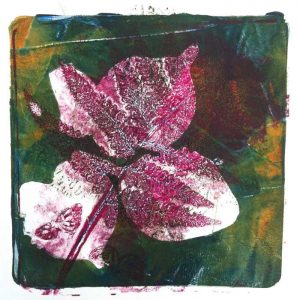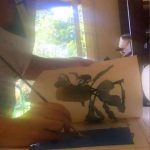Monoprint versus Monotype
Monoprint versus Monotype. Argh! What is the difference?
This is something that has confused me for years, but until now (I’m a little embarrassed to admit) I haven’t had the inclination to properly understand the difference. However, I have been invited to be a part of a postcard print exchange, and one of the printmaking media is monoprint. Now I think it’s the time to properly understand the difference between the two media.
During this educational process, I learned that I have been using the term ‘monoprint’ incorrectly. In effect, what I had previously termed ‘monoprint’ is actually a ‘monotype’. Hmm. Time to update category titles in my monoprint/monotype artwork gallery. Finding a definition that was clear to me was tricky. It took me a while to wrap my head around it, but now I think I understand.
Note: If, when reading this, you find that I have understood the definitions incorrectly, please let me know.
In my own words…
A monoprint is a one-of-a-kind print that forms part of a series. Much like an ‘edition variable’. Each finished print varies to the other, but a common element is present in each print. For example, a collagraph could be the common element, but each print is inked differently, chine collé applied in one or a few of the prints, and different marks made by subtracting or adding ink and texture in addition to the base collagraph plate or matrix.
A monotype is a one-of-a-kind print that will exist in its own ‘unique state’. It starts with a clean surface (for example: glass, gelatin plate, perspex), then adding ink or paint and working the surface to create an image before taking an impression on paper. This technique works beautifully when adding layers of colour and texture to the one print. The images below are layered monotype prints created using gelatin plates and acrylic paint, using different organic matter to create the image.
Both processes present endless opportunities for experimentation. I love to experiment with different techniques – for me it’s how I learn about printmaking in all its varied forms, and how I develop my own skill and find my own style. I suspect though that the skill and style development will be a lifelong learning. Pure bliss!

‘Red Cente’

‘Morning Glory’

‘How does your garden grow’
In the words of online professionals…
Source: Collectors Guide – What is a Monotype
A monoprint is one of a series—therefore, not wholly unique. A monoprint begins with an etched plate, a serigraph, lithograph or collograph. This underlying image remains the same and is common to each print in a given series. Other means of adding pigment or design are then employed to make each print in the series slightly different. The series of monoprints has a limited number of prints and each is numbered.
A monotype is one of a kind, a unique piece of artwork. It is the simplest form of printmaking, requiring only pigments, a surface on which to apply them, paper and some form of press.
and…
Source: What is a monoprint
A monotype is essentially ONE of a kind: mono is a Latin word which means ONE and type means kind. Therefore, a monotype is one printed image which does not have any form of matrix. On the other hand, a monoprint has some form of basic matrix.
The process of creating a monoprint or a monotype is the same, but when doing monotypes, the artist works on a clean and unetched plate; with monoprints, however, there is always a pattern or part of an image which is constantly repeated in each print. Artists often use etched plates or some kind of pattern such as lace, leaves, fabric or even rubber gaskets, to add texture. In this case, having a repeated pattern, we have a monoprint.
Interested in a Monotype workshop?
Monoprint and Monotype printing is fun, easy and contagious! Attend a one day workshop with me where you will play with found and organic shapes and objects to produce a series of monotype prints. You will learn how to take both a planned and sponantious approach to this printing method. You will also learn how you can apply this printmaking technique to other surfaces such as fabrics, and how you can continue at home with minimal investment in materials.
Examples of monoprints and monotype
A simple and fun approach to monotype to explore is working with gelatin plates. You can make the plates yourself, or buy them online (Gelli Arts) from various shops. A quick Google images search for “examples of monotype” reveals a host of different styles and approaches to creating monotype images.
I did the same “examples of monoprint” search, but you’ll see some of the same images in both searches, so you may need to drill down into different pages to know if which images really are monoprints versus monotypes.
I have a Pinterest board with a mix of monotype and monoprints. Have a look and see if you can see if you can spot the monotype versus monoprint prints.
I’ll finish here with a delicious 1970s video showing the art of marbling paper. It is in effect a monotype process. I look at the effect and see it as ‘old fashioned’, but at the same time I’m excited to give it a go and add it to my repertoire of printmaking skills. I’ll experiment and add my own twist, but the process and hands-on approach is so appealing to me.






Hi Annetta, that’s an interesting question! What are you using for the image transfer? Are you repeatedly using the same original image, same paper? Or re-printing it to use each time you want to transfer it to the gel plate? My first response is that it is a monotype, because the image made on the gel plate to transfer to your already-printed monotype is going to be different each time because you can only use the source image 1x maybe 2x. But – if you’re re-printing a laserprinted image to transfer, then it could create a repeatable image transfer image, making your print a monoprint, because there is a common and repeated image on the already-printed monotype. It is confusing! And to confuse it even more, it could be a ‘variable edition’ print, using the same image for the image transfer. I think make your own interpretation. It does get a bit tricky. happy printing. 🙂
With reference to your comment that gel plate prints are definitely monotype. If you do an image transfer onto the gel plate first and used the same transfer again but both with different monotype backgrounds what would they become then. The transfer would be the same on both prints even though the rest would be monotype. I find this really confusing. Thanks hope you can help clarify.
If I use plants and do spray paint to create prints could these be considered monotype or mono prints? I place the plants/ leaves on paper and spray the paper. I also wonder if I did gelli plate prints using plants… would it be called either of these 2?
Hi Maureen, after you “place the plants/ leaves on paper and spray the paper”, do you take a printed impression from that paper, or is that paper what you are calling the actual ‘print’? I would assume that using plants and spray paint to create prints is monotype. It sounds like you are doing ‘stencil printing’. The gel plate prints are definitely monotype prints. I hope that helps?? cheers, Kim
I’ve been teaching for 20 years, mainly Painting with Print as a sideline, and can’t find a distiction to seprate Monoprints and Monotypes that I’m happy with. I always thought of monoprints as when you place paper down on an inked surface and draw on the back and Monotype as when you do the drawing + and – on the inked surface before ‘lifting’ a print. I realised recently that this is not accurate but I do find it useful when I’m encouraging students to play with print.
Hi Neil, ‘monoprint’ is such a broad term and it does get confusing. You are right in your examples above, but there are so many more possibilities for both terms. I use ‘monoprint’ to reference both monotype and monoprints when talking in general terms, then differentiate with specific examples. You can create monoprints and monotype prints with soooo many different printmaking processes – linocut, screenprint, marbling, glass painting and more. So many exciting possibilities.
Hi Kim, so… do you number monoprints as E.V.? And I am about print my woodblocks but background of each print will be printed with brushstrokes, like in monotype, so only the background is different on each, which would make them monoprints, I think. Do I describe that as woodblock monoprint? Or just numbering E.V. and calling it woodblock print enough??
Hi Megumi, yes, I add EV to the edition numbering. Ive written another article about editioning that you might find interesting – https://kimherringe.com.au/printmaking/part-3-editioning-fine-art-prints/. I would probably be inclined to refer to work where the primary focus in the woodblock print as ‘woodblock monoprint’ and denote the edition numbering with EV. If you are printing as a limited edition you could annotate the numbering as EV1/10, EV2/10 etc. If you are printing as an open edition you could annotate as EV1, EV2 etc.. I hope that helps??? cheers, Kim 🙂
Hi Kim. I commend you for taking on the task of defining monotype vs. monoprint. Take a look at the book, The Painterly Print if you haven’t already. It’s a catalog of an exhibition at the Met in NY in the 80’s. I believe it’s out of print but you could probably order it through the library or get a used copy on Amazon. In it the terms monotype and monoprint are defined by the printmaker Michael Mazur, specifically pp. 55-61. I used to teach printmaking and got asked this question all the time. And this book is great for historical reference too.
Hi Lisa, thank you for the book recommendation! Ive not heard of it and will hunt for it. 🙂
Hi thank for your post, I too have been confused over ‘monos’
I’m trying to find out if it is acceptable to hand colour detail on a monotype after it’s printed ?
For example the the fine lines of veins on a leaf or the eyes on a bird?
Hi Joe, personally I think it is acceptable. I have hand-coloured small areas of a linocut print in the past, and still refer to it as a print. I do state that any documentation about the print that there is hand colouring in it. So you could describe the print as “monotype with hand colouring”. I hope that helps. cheers, Kim
Hi, Kim. Thanks so much for this post – very interesting. I found out that the contents of the Cockerell Bindery were sold at auction on March 27, 1990. For anyone who wants to look that up, here’s the link.
https://cool.culturalheritage.org/byorg/abbey/an/an13/an13-8/an13-813.html
Hi Mary, can you imagine the treasures that would have been available at that auction! Glad to hear that it was sold and didn’t end up in landfill like so many treasures relating to tradition crafts.
Are cyanotypes and lumens considered monotypes or monoprints? Thank you!
Hi Alex, my personal thinking is (but I could be wrong) … if you are making a cyanotype or lumen ‘photogram’ using 3D objects, using the sun as your UV light, I would consider that a monotype, as it would be near impossible to achieve exactly the same result twice, existing in one unique state. If you were creating a series of prints the same or similar objects, you probably could classify them monoprint based on your own interpretation of the definition. I think if you read the definition for both, consider what you are presenting, then make your best judgement call, as I think there is room for interpretation. If you were using a negative/positive film/acetate as a contact print, then you could potentially create an edition, especially if you were using controlled UV lighting, and replicate the same print multiple times. I hope that helps. cheers, Kim
Thevword “mono” is not latin
Hi Feldt, thanks for that. I just looked it up – its Greek. That reference above was on the monoprints.com website. I did a quick search and found this online ““Mono” is from Greek and “uni” from Latin, and there is a mild preference to use the prefix derived from the same language as the main word. … “Mono” carries a stronger sense of the meaning “alone” than “uni”.“
Thank you for this article 😀
It’s Ebru technique on film 😀
You are very welcome Kamila. I’ve not heard of Ebru techinique before. Thank you – I will look that up 🙂